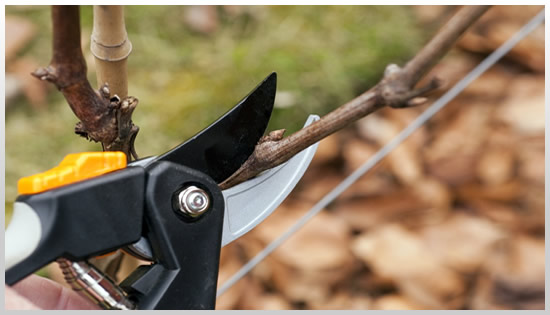WHEN TO TRIM YOUR TREES AND SHRUBS

WORK WITH NATURE AND THE SEASONS TO PRUNE FLOWERING SHRUBS
Few gardening chores are approached with more trepidation than pruning. In reality, it's a relatively simple process that requires a little basic knowledge, some common sense and the proper tools.
The number-one rule of pruning is don't fight nature. When selecting flowering shrubs, save yourself some work by carefully considering the ultimate size of the plant and where it is to be located. Pruning should enhance the natural shape and performance of your shrub, not disguise mistakes made in plant selection or placement. Prune to remove dead or damaged wood or unwanted growth, improve shape or create special effects, rejuvenate old plants, and promote flowering, fruit production, or colourful stems or foliage.
When should you prune?
An old adage says, "Prune when the knife is sharp," but it is wrong to suggest that effective pruning can be done at any time. As a general rule of thumb, avoid pruning any flowering shrub in late summer or autumn because this can stimulate tender new growth, which is susceptible to damage by cold temperatures.
Spring flowering shrubs such as forsythia, purple sandcherry, flowering almond, lilac and mockorange bloom on the previous season's growth, sometimes referred to as "old wood". In other words, the flowers we see this April, May and June actually developed on the plant late last summer. For maximum flower production next year, prune spring flowering shrubs immediately after they bloom.
Summer and early-autumn flowering shrubs such as butterfly bush, rose of Sharon and Peegee hydrangea bloom on the current season's growth or "new wood," which means flowers have developed since growth started that spring. These plants should be pruned just as growth starts in spring.
Pruning know-how
Start with clean, sharp, good-quality tools appropriate for the job at hand. To prevent the possible spread of disease, clean your tools after pruning each plant with a solution of one part chlorine bleach or rubbing alcohol diluted with ten parts water. A spray bottle of solution works efficiently and reduces mess.
Mature flowering shrubs benefit from a pruning every two to three years. This helps maintain the plant's health and vigor and enhances its appearance.
Step 1
First, remove any dead or diseased wood. Next, select two to four of the oldest, largest stems, equally spaced around the shrub. When removing old stems, try to make the cut as close to the base of the stem as possible.
Step 2
You may need to prune some of the younger stems and suckers as well. Start by removing any branches that are crossing or rubbing against each other, then prune those that look out of place or are crowding the centre of the plant. Aim to leave a balanced variety of old and new, big and small stems.
Step 3
In general, to head back a stem that's too long, make the cut just above a bud that is facing in the direction you want the new growth to go usually toward the outside of the plant. This keeps the centre of the shrub open, which is important for good air circulation, and looks more natural. If the plant has opposite leaves and one bud is facing in the wrong direction, simply rub it off. Do not leave stubs above the buds, as they will die.
How to rejuvenate an overgrown shrub:
It may be necessary to take more drastic action to rejuvenate an overgrown flowering shrub: cut back all stems to within five centimetres of the base in late winter or early spring before new growth starts. Flowers will be sacrificed for the first year, and it may take a season or two for the plant to recover completely, but the overall improvement can be dramatic. Once the plant has returned to a normal size, implement a regular two- to three-year pruning regimen.
Some shrubs benefit from an annual or frequent hard cutting back. For example, red osier dogwood, which is grown for its colourful stems, should be pruned every few years, as the youngest stems have the brightest colour. And a number of somewhat tender and late-flowering shrubs, such as butterfly bush, hills-of-snow hydrangea and blue spirea, should be cut back each spring.
Source:
Canadian Gardening
Article: When to trim your trees and shrubs
www.canadiangardening.com





